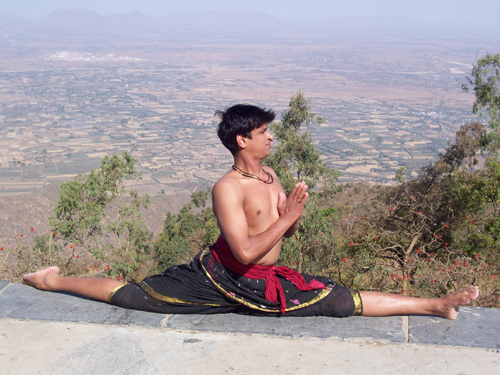User:Travel&Heritage
Ayurveda and Kalari[edit]
Kalari, the world’s oldest martial art, finds mention in the Vedas and many other ancient leaf scriptures. Vishnu Avatar, Sage and warrior Parshurama, is believed to be the father of this martial art. Although it was in existence for the longest of all martial arts, it evolved and reached its pinnacle around the 11 century A.D when wars between Cholas, Cheras and Pandyas were frequent, hence, the martial art evolved in southern India and especially in Kerala. During the periods of war the skills and techniques for the war refined and it became a social custom in Kerala to teach the young this martial art. During the British occupation of India, however this martial art suffered a set back and the training and teaching was restricted, away from the eyes of the British. [1]
The fact that this martial art has survived and thrived at several periods of history speaks volumes of this science of Kalari, which bases itself on a system of Mental and physical synergies, combined with the sciences of Ayurveda for healing and Yoga for training.
The martial art has developed to use several weapons and the usage of the 108 critical points of the Human body called the marma points. See more details of the science of Marma at the site - Marma treatments in Kalari[2]
The postures and body movements have also been extensively borrowed from the rich animal kingdom which has a wide variety and forms of attacks and defenses. Note some of them in the photos below. The picture below is borrowed from the peacock. There are several others which are from the Lion (Simhavadivu) and tiger. Kalaripayattu Techniques

The art of Kalari refined and developed to utilize almost all the weapons that have existed during the early times including the Long staff or pirambu , Kurunthadi , Valum parichayum or sword, Vettukathi or knife, Churika similar to a knife, Chuttuval ( flexible sword) or urumi (one of the most dangerous of all weapons which needs extensive practice), Kottukampu or Thavikkana and Verumkai ( without any weapon).
The utilization of weapons for the practice and use of Kalari martial art led to injuries which were inevitable and this paved way for the parallel evolution of a healing and medicinal system. Ayurveda provided the backbone for the healing system along with the usage of the critical point ( marma ) knowledge. This healing system has now matured today as the Kalari treatment. But, the similarities between the two are still quite strongly evident.
Kalari training demands strong mental power, extremely fast reactions( reflexes), and a agile and flexible body. The rapid responses and fast turns and jumps require the body to be extremely fit and light weight, which is in contrast to many self defense martial arts which depend on a strong and full body. In order to develop these, Kalari depended on Yoga training and Ayurveda extensively. Before any practice, the Kalari trainers and trainees would apply a concoction of herbal oils on the body to acquire flexibility. The oil massage makes the muscles react better and renders endurance, swiftness and flexibility. Some of these oils even act on the nervous system and increase the reflex speeds lowering the reaction times of the practitioners of this art. These herbal oils have now become a part of the Kalari treatments but they originated from the science of Ayurveda.

Since the martial art primarily dealt with warfare, injuries and wounds were inevitable and hence the science of kalari incorporated effective treatments from ayurveda for cure of wounds, burses, dislocations and fractures. Healing has always been an important part of martial arts. You cannot be a fighter without knowing how to heal your wounds. Treatments in Kalari make use of Ayurvedic herbs and herbal preparations and provide instant relief.
The Sushruta samhita, by Sushruta is the basis of the origin of the Marma points identification. These marma points have been used in Kalari for the defense. Experts or Gurukkals of Kalari can immobilize or kill their opponents/attacker merely by applying pressure on these vital points. The science of surgery in Ayurveda is also based on the Sushruta Samhita, which explains the deeply knit evolution of these two sciences Ayurveda and Kalari.
Although the connection between the science of Ayurveda and Kalari may not be very apparent but neither is the demarcation. Ayurveda has been providing a backbone for the evolution and growth of Kalari. It has been lending its science to enhance flexibility and gain the physical fitness from the body that this martial art requires as well as been healing all injuries that result from the practice and use of this art.
By Ayurveda and Kalari (talk) 05:57, 1 January 2009 (UTC)
- ^ Kalarippayattu origins, Kalari history.
- ^ Marma knowledge, Marma points.


